Karajá people
|
Karajá feather headdress from Mato Grosso, Muséum d'Histoire naturelle de La Rochelle | |
| Total population | |
|---|---|
| 2,500-3,000 | |
| Regions with significant populations | |
|
| |
| Languages | |
| Karajá language | |
| Religion | |
| traditional tribal religion |
The Karajá, also known as Iny, are a tribe indigenous to the Brazilian Amazon.[1]
Territory
Karajá people live in a 180-mile-long area in central Brazil,[2] in the Goiás, Mato Grosso, Pará, and Tocantins provinces. They currently reside in 29 villages in the Araguaia River valley, near lakes and tributaries to the Araguaia and Javaés Rivers, and the Ilha do Bananal.[1]
Population
Earlier in the 20th century, there were 45,000 Karajá. In 1999, there were 2500–3000 Karajá.[1][2] In 2010, there were 3,198 Karajá.
History
In 1673 the tribe first encountered European explorers.[1] In 1811, the Empire of Brazil, based in Rio de Janeiro, waged war against the Karajá and neighboring tribes. The Karajá and Xavante retaliated by destroying the presidio of Santa Maria do Araguia in 1812.[3] During the mid-20th century, the tribe was overseen by Brazil's federal Indian bureau, the Serviço de Proteção aos Índios or SPI.[4]
In the 1980s and 1990s, the Karajá community leader, Idjarruri Karaja, campaigned for better education, land rights, and employment opportunities for the tribe. Karaja also brought electricity and telecommunications to the tribe in 1997.[2]
Language
They speak the Karajá language, which is part of the Macro-je language family.[1]
Economy
Although they are known as one of Brazil's poorest tribes,[2] they are self-sufficient. Their livelihood is based upon agriculture and craft work. Crops are diverse and include bananas, beans, manioc, maize, peanuts, potatoes, watermelons, and yams. Fishing is also highly important, as is hunting. Ceramics dolls are commonly made for export.[1]
Culture and arts
Karajá are highly mobile people. Families often build temporary fishing camps. During the Amazon's dry season, the tribe hosts festivals. In the rainy seasons, families move to villages on high ground. They employ swidden or slash-and-burn techniques in farming. Men govern group decision-making and negotiation with outside groups, such as NGOs.[1]
Body painting still thrives as an art among Karajá, with women specializing in this medium, which employ paints made from genipap juice, charcoal, and annatto dye. Both women and men weave baskets, while only women create ceramics. Karajá excel at feather work.[1]
-

Cart art lid "Warabahu" MHNT
-

Cart art lid "tarirana" MHNT
-
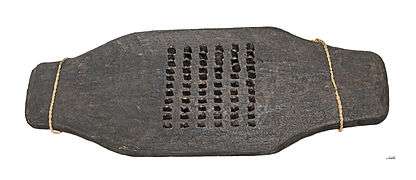
"Orana" - Cassava grater MHNT
-
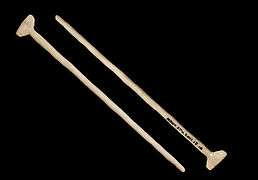
"Holua" - Vertical labret MHNT
-
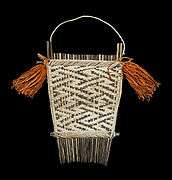
“Siho” comb MHNT
-
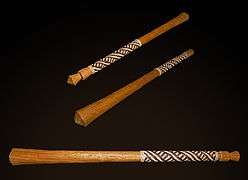
Mace "Otote" MHNT
-
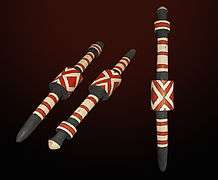
Funeral pile "itxeo"
See also
- Uaica, hunter in Karajá legend
Notes
References
- Garfield, Seth. Indigenous Struggle at the Heart of Brazil: State Policy, Frontier Expansion, and the Xavante Indians, 1937–1988. Durham, NC: Duke University Press, 2001. ISBN 978-0-8223-2665-6.
